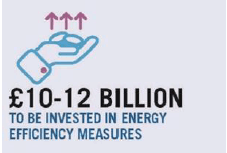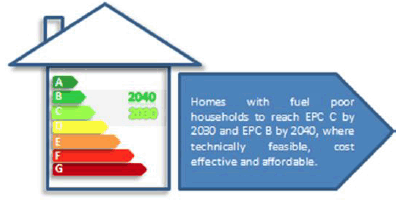Draft Fuel Poverty Strategy for Scotland 2018
The draft fuel poverty strategy sets out the policy development of the Fuel Poverty (Target, Definition and Strategy)(Scotland) Bill and the draft Fuel Poverty Strategy for Scotland 2018.
Delivering the Strategy
We will achieve these world leading fuel poverty targets by:
- Continuing to grant fund low income households to install energy efficiency measures through our area based and national fuel poverty programmes
- Improving energy efficiency by introducing new standards for all tenures, including through the Energy Efficiency Standard for Social Housing ( EESSH), and proposals for new standards in the Private Rented and Owner Occupied sectors
- Providing advice and support to householders on ways to save energy and improve access to affordable energy, including by switching suppliers
- Maximising incomes, through increasing the availability of low carbon jobs in local communities and addressing poverty and inequalities through actions set out in our Fairer Scotland Action Plan, such as encouraging benefits take-up.
Action to address poor energy efficiency
Through our current and future energy efficiency and fuel poverty programmes we will build on the measures already delivered through a range of programmes to over 1 million households since 2008 and are committed to investing half a billion pounds available for fuel poverty and energy efficiency over the four years to 2021. We are continuing our work to make sure as many people across Scotland as possible have a warm, energy efficient home.
We are committed to removing poor energy efficiency as a driver of fuel poverty. The Energy Efficient Scotland programme will be the primary mechanism by which this is achieved. Energy Efficient Scotland takes a cross-sectoral and multi-faceted approach to improving energy efficiency and, by extension, tackling fuel poverty. The Energy Efficient Scotland Route Map [10] , published on 2 May 2018, sets out the steps that will be taken through the programme to deliver the transformational change necessary to tackle poor energy efficiency and help meet our Climate Change ambitions.
It also confirms that the programme will help secure an investment in excess of £10 billion over its lifetime, bringing numerous economic benefits for Scotland.

Infographic Text:
£10-12 Billion To be invested in energy efficiency measures
The Route Map re-confirms our commitment to continue to provide grant funding to low income households through our national and area based fuel poverty programmes. It also confirms our intention to set a Long Term Standard for improved energy efficiency in all homes across Scotland. We are proposing that all domestic properties are required to achieve an Energy Performance Certificate ( EPC) energy efficiency rating of at least EPC C by 2040 at the latest. Reaching the Long Term Standard will require a mixture of encouragement and regulation that will differ between the social rented, the private rented and the owner occupied sectors.
Social Housing Standards
As a result of the Energy Efficiency Standard for Social Housing ( EESSH), homes in the social rented sector are some of the most energy efficient in Scotland. We want to continue the excellent progress that has been made and are proposing new measures in the Route Map to ensure more homes reach a higher standard in that sector.
Private Rented Sector Standards
People living in private rented accommodation generally live in homes that have poorer energy efficiency than elsewhere in the domestic sector. We want to ensure this is properly addressed and so we are proposing to bring forward regulations to require that, where there is a change in tenancy after 1 April 2020, the energy efficiency of the property will need to be improved.
Owner occupied Sector Standards
We want to encourage not compel home owners to improve the energy efficiency of their homes. So we will work with stakeholders and owner occupiers to encourage the uptake of our offer and supporting local authorities to deliver area based schemes that will see ‘end-to-end’ support from initial advice through to quality assured installation of measures.
Fuel Poor Household Standards
Due to the depth of fuel poverty experienced in some households we know that reaching EPC C will not be enough to lift all households out of fuel poverty. That is why we are proposing a higher ambition for fuel poor households, regardless of tenure. The Route Map sets out these ambitious targets which will act as a guide for our national and area-based fuel poverty programmes. In practice this will mean maximising the level of improvement possible within limits affordable to the public purse.

Infographic Text:
Homes with fuel poor households to reach EPC C by 2030 and EPC B by 2040, where technically feasible, cost effective and affordable
Action to increase access to affordable energy
It is critical that all consumers are able to afford adequate heat and power for their homes and also that companies are able to sustainably provide energy to customers. Currently, the domestic energy market charges a premium to loyal customers. It is often the case that these loyal customers are also the least able to pay resulting in a situation where customers more likely to be vulnerable or in fuel poverty subsidise the lower tariffs charged to the better off, more engaged customers.
Consumer engagement will remain important to ensure competitive pressures drive down prices and we are working to promote Scottish consumer engagement.

In November 2016 we launched an impartial switching support service partnership between Home Energy Scotland ( HES) and Citrus Energy, to simplify the process for those who don’t have the internet or find it hard to navigate comparison sites. Citrus Energy are a social enterprise set up to provide an independent and impartial energy switching service to help Scottish households find the best energy deal from the whole UK energy market specific to their individual energy needs. Since the launch of this partnership between HES and Citrus Energy, 9,635 people have been referred to the service; and on average customers are saving £226 per year. We aim to offer this kind of support to low income households. We recently completed a pilot project to engage face to face with consumers and help them to switch.
Case study: Home Energy Scotland referred a customer to Citrus and when contacted Citrus established that they had a dual Meter Point Administration Number (MPAN) – a unique 13 digit reference used in Great Britain which identifies each electricity supply point. They also had a restricted meter in an all-electric property. Their pattern of usage was discussed to ensure they were making the most of the off-peak times. It was also established they were on a standard variable tariff. Citrus called their supplier and provided meter readings to confirm the annual energy consumption. Once billing had been corrected, the customer was more than £800 in credit and Citrus arranged for this to be refunded to the customer. Citrus also established that there was a cheaper tariff available with the customer’s existing supplier and, with agreement, switched them to that tariff. Based on their previous energy consumption it was estimated that they could save more than £1,600 per year on their new tariff.
We are also exploring a range of additional options to open up access to affordable energy. This includes establishing a public energy company to contribute to tackling fuel poverty and supporting economic development. The aim is to have the new company set up by the end of the current Parliament with a commitment to undertake wide engagement including a formal public consultation during the latter half of 2018. This will ensure all interested stakeholders will have the opportunity to input.
Action to maximise incomes
UK Government welfare cuts are increasing pressure on many household incomes across Scotland. The Scottish Government expect to spend over £125 million in 2018-19 to help relieve the worst impact of UK Government welfare cuts and to support those on low incomes; an increase of over £20 million from 2017-18. This investment allows for key initiatives such as mitigation of the bedroom tax and support for people in crisis through the Scottish Welfare Fund. Welfare cuts impact on the ability of fuel poor households, especially those on lower incomes, to rise above the new 90% MIS income threshold or to reduce their required fuel costs below 10% of their After Housing Cost Income.
We recognise that an effective way to lift people out of fuel poverty is to maximise their incomes, and we would urge everyone to check they are receiving all the benefits they are entitled to.
The Social Security (Scotland) Act, establishing Scotland’s first social security system, was passed by Parliament in April 2018. Social Security Scotland, the new agency, will be responsible for the delivery of 11 devolved benefits to 1.4 million people a year, worth around £3.3 billion. Social Security Scotland will clearly have a very important role in making sure that everyone gets the financial support they are entitled to.
This is the most significant transfer of powers since devolution began and establishes a new public service for Scotland. Our system will be rights based, with a range of rights and policies that stand in marked contrast to the current welfare system including the right to independent advocacy for those who need it; fast-tracked arrangements and no arbitrary timescale for people with terminal illness; the right to have a supporter at all steps of the way, and the right to challenge decisions without having your money instantly cut.
We are agreed that a phased approach is the right way to ensure the safe and smooth transfer of the 11 benefits to be devolved. Our first payments will be made in summer 2018 when the Carers Allowance Supplement is introduced - a 13% increase to the current Carers Allowance.
Among the benefits being devolved to the Scottish Parliament are the Winter Fuel Payment ( WFP) and the Cold Weather Payment ( CWP). The WFP provides an annual payment of between £100 and £300 to people above the women’s state pension age to help them cope with higher heating costs during the winter months. Cold weather payments, as the name suggests, are paid out during periods of particularly cold weather to individuals in receipt of a variety of qualifying benefits. We are committed to protecting the WFP from means testing and will also extend eligibility to families with severely disabled children.
The Scotland Act 2016 also provides Scottish Ministers with very limited powers over some elements of the Energy Company Obligation ( ECO) and the Warm Home Discount ( WHD). Both these schemes operate under a framework set by the UK Government, but are delivered as an obligation by the big energy suppliers, with ECO offering subsidised installations of home energy efficiency improvements, while WHD provides an annual rebate worth £140 to vulnerable and low income energy customers. Regrettably, the UK Government has failed to provide any degree of certainty about the future of these schemes beyond the early 2020s. Combined with the severely constrained nature of the currently available devolved powers this uncertainty makes it impossible for us to determine whether creating Scottish versions of ECO and WHD would have real benefits for the people of Scotland. However, we continue to seek clarity from the UK Government about the long-term future of both schemes, along with a dialogue on the nature of the devolved powers, so that more meaningful versions can be delivered in Scotland, which truly align with our efforts to tackle fuel poverty. In the meantime we will continue to participate in the GB wide schemes.
Action to help people use their energy efficiently
As well as improving the physical fabric of homes, it is equally important that we support home owners to change their behaviours so that they can control their heating system helping to reduce spend on energy costs and get the most out of energy efficiency improvements.
Behaviour change is already at the heart of our energy efficiency programmes and will continue to be so as Energy Efficient Scotland is developed and rolled out. The Scottish Government also funds Home Energy Scotland and Resource Efficient Scotland who provide free, impartial and expert advice to property owners on energy saving behaviours. We will explore areas where we can promote behaviour change further and set this out in more detail in the Fuel Poverty Strategy to be published in 2019 under the new legislation.
A Fuel Poverty Strategy for all of Scotland
Our new approach has to be fair for everyone, no matter where they live in Scotland.
A country as diverse as Scotland requires an approach to tackling fuel poverty which reflects those differences, is fair and can be delivered. Our strategy has to reflect the different needs of Scotland’s urban, suburban, rural and remote communities. We highlighted in our consultation that addressing fuel poverty in our island communities presents a different set of issues to many other parts of Scotland. Properties in remote and rural areas tend to be more exposed to wind and weather and can be more expensive to heat as the majority are not connected to mains gas supplies and households are reliant on electricity and unregulated fuel types to heat their homes. These issues are already taken account of in the way we define and measure fuel poverty, but our approach to delivering appropriate solutions for those areas must take account of both the challenges and the opportunities that island and remote rural community life presents.
Current delivery of our fuel poverty programmes attempts to compensate for the challenges of delivering solutions in remote and island communities. Our HEEPS: Area Based Scheme distributes funding based on an assessment of need meaning that remote areas, including all island communities, currently receive over three times more per fuel poor household to tackle fuel poverty than the next highest area, on the mainland.
In addition our HEEPS: Warmer Homes Scotland scheme operates a ‘National Customer Price’ mechanism. This is designed to take into account the additional costs of delivering energy efficiency measures in the islands and other remote regions but ensures that customers in these areas get access to the same quality of service and the same amount of measures that those in the more accessible regions do. It also means customers pay the same rate for additional radiators or for measures which exceed the grant maximums irrespective of where they live. This mechanism ensures contributions are minimised for households in remote areas for recommended measures beyond the standard ones installed by the delivery agent, Warmworks. We have listened to concerns from rural stakeholders about ensuring the scheme is designed to help rural households. We are in the process of introducing new enabling and renewable measures to the scheme, which will directly benefit those in rural communities, including fuel tanks for oil and LPG heating systems, asbestos removal and new renewable measures including ground source heat pumps.
Delivery in urban areas is also challenging. It can be possible to deliver projects at scale in urban areas but there are often deep-rooted issues of poverty and vulnerability to take into account. Our urban communities contain large numbers of properties such as pre-1919 tenements and high rise buildings which may require expensive solutions and projects can involve liaison and negotiation with multiple owners in blocks of properties.
Just as Scotland’s Energy Strategy proposes a smarter, more co-ordinated, approach to planning and meeting distinct local energy needs, our Fuel Poverty Strategy must also take this approach. Through both of these strategies we need to ensure the strong link to national progress remains, and that responses put in place are flexible and proportionate to the challenges raised across Scotland as a whole.
Supporting and delivering local solutions to meet local needs is important to us. This approach could be supported by the proposed framework for Local Heat and Energy Efficiency Strategies ( LHEES) which would offer Local Authorities, as part of Energy Efficient Scotland, support and the mechanisms to prioritise the improvement of the building stock in the area – to take a strategic approach as well as plan for low carbon heat.
We want to ensure all of our communities benefit from our programmes and so we will continue to work closely with all local authorities, rural and urban to further explore opportunities that will help ensure our programmes address the needs of all of our communities whilst helping to deliver real reductions in fuel poverty across Scotland.
Developing a fuel poverty assessment tool
We previously made a commitment to review the eligibility criteria of the Warmer Homes Scotland scheme and at that time the Fuel Poverty Forum recommended that, as Ministers had accepted the recommendations of the two fuel poverty working groups to review the current definition of fuel poverty, we postpone that review until after that process had been complete. We will now commit to undertake that review of the scheme eligibility for Warmer Homes Scotland, taking account of the proposed definition from the independent panel in order that we can use this to help target support to those who need it most. And as part of this we will consider the development of a fuel poverty assessment tool to ensure that our funding goes to those households who need assistance the most. We will take this forward with a view to implementing any changes to the scheme that may be required after commencement of the Bill. We will discuss with the Fuel Poverty Advisory Panel how best to undertake the review, and will ensure that the results of the review will feed into the next tender exercise for the future national scheme and will ensure the development of this meets the objectives of the strategy.
Contact
There is a problem
Thanks for your feedback